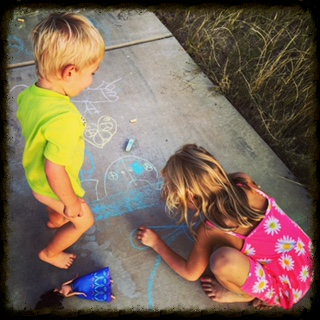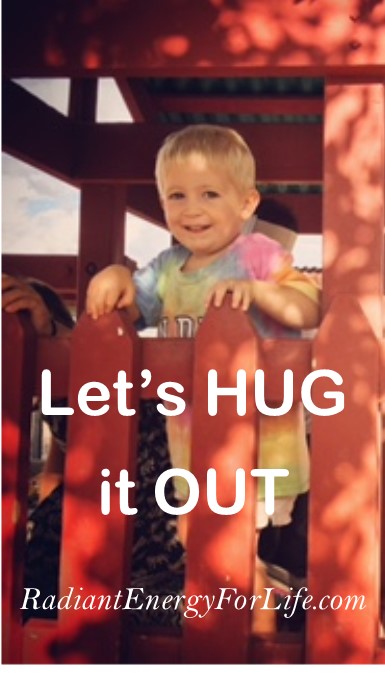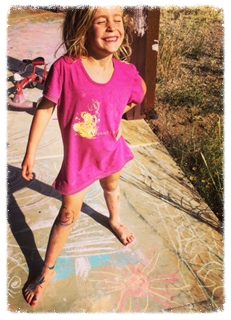Any mindfulness practice is going to bump up against the inner “control freak” – the one who wants to be in charge of how everything turns out.
I recently enjoyed a series of full days of solo “mommy time” with my two little kids. Parenting is always such a lesson – a lesson in letting go, in boundary-setting, in dealing with inner (and outer) control freaks, in multi-tasking, and especially in connecting from the heart.
The challenge of supporting my little ones in what they want to do, while setting limits in order to keep them safe and well, highlights today’s topic: Radical acceptance AND.
 |
| Ava designing a “Peace Library” while Aiden looks on |
Years ago, I made a conscious choice in my parenting to limit my use of the word “no,” and instead of just “laying down the law,” by behaving in a domineering way, and instead of using such comments as, “because I said so” – to choose logic and reason – whenever possible – to help my children understand why.
Why they should not jump on the couch (they could fall and hurt their heads on the hard tile floor), why they should help pick up their toys (so we don’t trip over them or accidentally break them), why I need some space around the stove when I’m cooking (to avoid getting burned), etc.
When chaos breaks loose, I can radically accept that my two-year old is hitting my six-year old with a library book. However, if I leave it at that, I’m neither a good Yogi nor a good Mama.
I must also radically accept that it is my role as a parent to intervene, even if I am starting to feel overwhelmed, irritated, shocked, fearful, saddened, personally insulted, or any of the other myriad of emotions that arise at such times.
In fact, after the physical danger has been dealt with, I find the greatest danger lies in taking such incidents personally.
It’s true, my son may be misbehaving deliberately in order to test his limits with me, but he is not doing this because he doesn’t “like” me, or because I am a “bad” parent. It’s not “personal” in that sense.
As an Eponaquest EFL instructor, I’m trained to read “misbehavior” in a horse as a form of communication.
It is the same with children.
What if it’s possible that it is the same with everyone?

Practicing radical acceptance – accepting that “this” is what is happening (whatever “this” is) helps me not take the misbehavior personally, but instead, become curious about what is being communicated and why.
However, if I leave it at that, I’m neither a good horse communicator nor a good parent.
Interconnection
One of my favorite teachings from the Dalai Lama is the acceptance of the fact that we are all intimately interconnected. This is also one meaning of Yoga: connection.
What I do, affects you. What you do, affects me. What we do, or don’t do, in our daily choices, affects our world and everyone in it.
As Merry says to Treebeard in Lord of the Rings: “You’re part of this world, aren’t you?”
To me, this teaching resonates with a saying that has haunted me since my schooldays:
If not me, who? If not now, when?
That’s the “AND.”
Tara Mohr describes it well in her beautiful poem, “You Shaped Hole.”
The world has a you-shaped hole in it.
Filling it is speaking what is missing…
And it’s not easy.
There are times when I’d rather just read my book and let them clobber each other. But, to continue the Rabbinical saying, “If I am only for myself, what am I?”

As we used to say in Philosophy class, radical acceptance is necessary, but not sufficient – at least depending on the role we’re playing in this lifetime. It’s definitely not sufficient to conscious parenting.
But it’s a start.
Why Radical Acceptance first?
I love the Yogic value of identifying with the witnessing consciousness. It brings such a calming, non-judgmental and centered acceptance of whatever events may be arising. Accepting and bowing to “what is” permits us to see the bigger picture, helps us to not take things personally.
It takes a lot of skill to maintain a witnessing consciousness in the midst of a chaotic situation, yet it can be done.
Holding that “witnessing” space has two powerful effects:
- It keeps the observer calm
- It raises the possibility for right action, when action is needed, rather than reactivity
- It opens the potential for “selfless” action – action that is not about “me” or “ego,” but that serves the process somehow, that attends to “what is missing” somehow
From the space of the witnessing consciousness, which accepts the situation and the behavior without shaming or judgment, centered, helpful action becomes possible – not as a way to try to “control” the situation, but in order to provide a safe space for everyone to grow and learn.

Sometimes, radical acceptance – accepting without judgment – occupying the space of witnessing consciousness with a calm mind and heart – is enough.
Because we ARE all intimately interconnected, remaining calm in the midst of chaos will affect the situation, usually for the better.
Yet when radical acceptance is not enough, when people are at risk of getting hurt, or are already hurt, for instance, taking centered action from a space of non-judgmental compassion is necessary.
Radical acceptance AND…
What?
AND… is for each of us to fill in the blank, holding the big picture, honoring compassion, selflessness, ahimsa (reverence for life), as much as we can in the moment.
Usually, it means some kind of compassionate action, and we can’t know in advance what that will look like.
Some of the actions I take include:
- Guiding my children in feeling compassion for each other
- Helping them see the positive or negative consequences of their actions
- Encouraging them to reconnect after a disagreement
- Teaching them how to care for each other so that our family is a safe place
Radical acceptance AND… what next?
If you do “add” the AND, consider doing it not to “win” over the other person, not to “prove you’re right” or make another “wrong,” not to assert “control” or “dominance” or “superiority,” but get back to neutral – to provide a space where learning and growth are possible.
The use of Radical Acceptance AND thoughtful, compassionate action applies to power struggles of many kinds, not just those that sometimes arise in the tempests of two-year-olds.
Namaste,
Erin

Want to share your thoughts? Post to the Living Joyfully blog page below, or email me: Erin@RadiantEnergyforLife.com
